Accounting Principles and Financial Reporting Assignment
VerifiedAdded on 2021/05/31
|23
|1676
|46
Homework Assignment
AI Summary
This accounting assignment solution covers various key concepts in financial accounting. It begins with an explanation of the trial balance, its purpose, and limitations. The solution then delves into accrual accounting, contrasting it with the cash basis and emphasizing the matching concept. The assignment further explores the conceptual framework of accounting, highlighting qualitative characteristics such as verifiability, comparability, and understandability. It also discusses the impact of credit cards on financial management, particularly concerning accounts receivable. Depreciation methods, including the straight-line and diminishing value methods, are analyzed, along with asset revaluation. The solution provides detailed journal entries and explores inventory valuation methods, including perpetual systems and the lower of cost or net realizable value principle. Finally, the assignment touches upon revenue recognition and the importance of sustainability reporting.
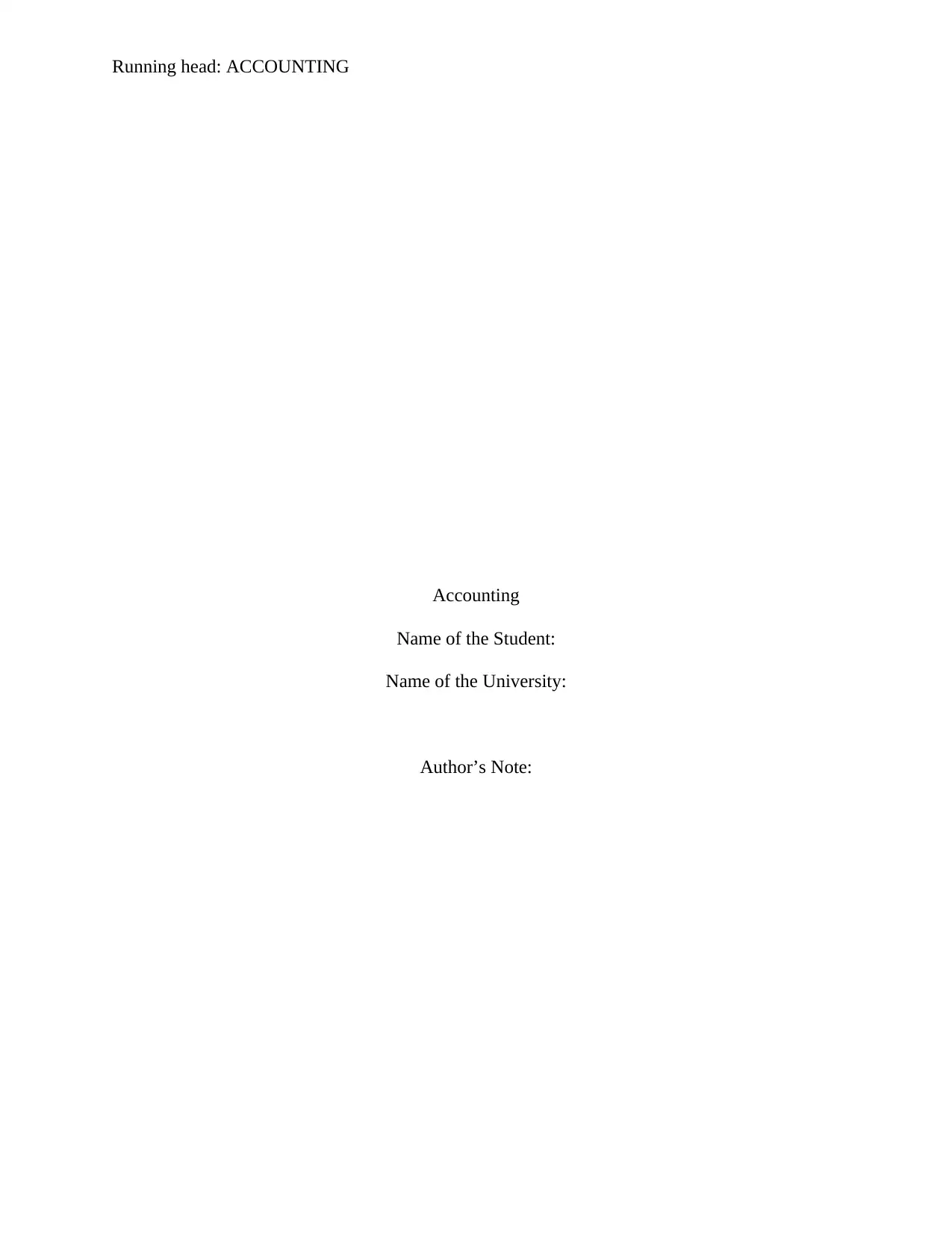
Running head: ACCOUNTING
Accounting
Name of the Student:
Name of the University:
Author’s Note:
Accounting
Name of the Student:
Name of the University:
Author’s Note:
Paraphrase This Document
Need a fresh take? Get an instant paraphrase of this document with our AI Paraphraser
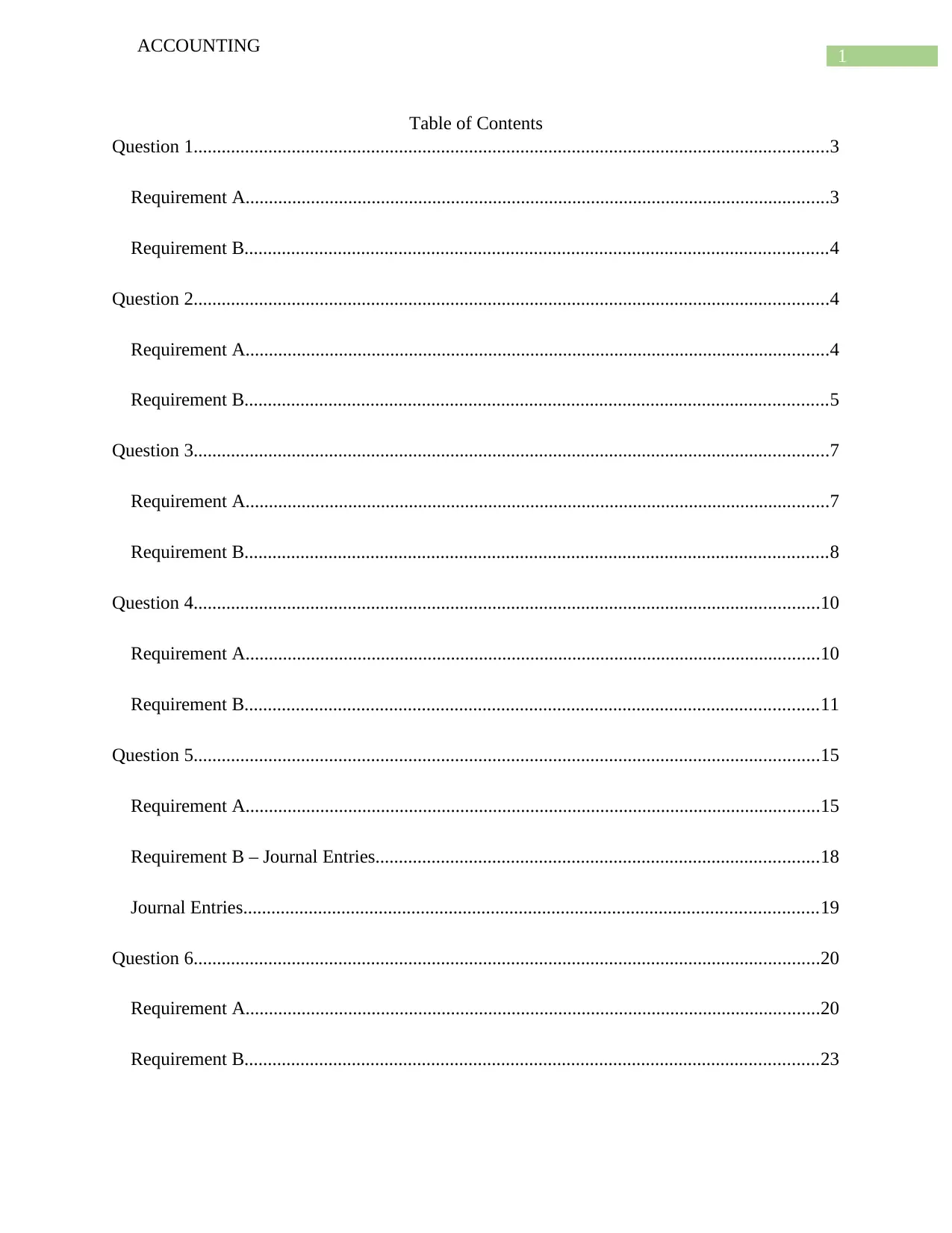
1
ACCOUNTING
Table of Contents
Question 1........................................................................................................................................3
Requirement A.............................................................................................................................3
Requirement B.............................................................................................................................4
Question 2........................................................................................................................................4
Requirement A.............................................................................................................................4
Requirement B.............................................................................................................................5
Question 3........................................................................................................................................7
Requirement A.............................................................................................................................7
Requirement B.............................................................................................................................8
Question 4......................................................................................................................................10
Requirement A...........................................................................................................................10
Requirement B...........................................................................................................................11
Question 5......................................................................................................................................15
Requirement A...........................................................................................................................15
Requirement B – Journal Entries...............................................................................................18
Journal Entries...........................................................................................................................19
Question 6......................................................................................................................................20
Requirement A...........................................................................................................................20
Requirement B...........................................................................................................................23
ACCOUNTING
Table of Contents
Question 1........................................................................................................................................3
Requirement A.............................................................................................................................3
Requirement B.............................................................................................................................4
Question 2........................................................................................................................................4
Requirement A.............................................................................................................................4
Requirement B.............................................................................................................................5
Question 3........................................................................................................................................7
Requirement A.............................................................................................................................7
Requirement B.............................................................................................................................8
Question 4......................................................................................................................................10
Requirement A...........................................................................................................................10
Requirement B...........................................................................................................................11
Question 5......................................................................................................................................15
Requirement A...........................................................................................................................15
Requirement B – Journal Entries...............................................................................................18
Journal Entries...........................................................................................................................19
Question 6......................................................................................................................................20
Requirement A...........................................................................................................................20
Requirement B...........................................................................................................................23
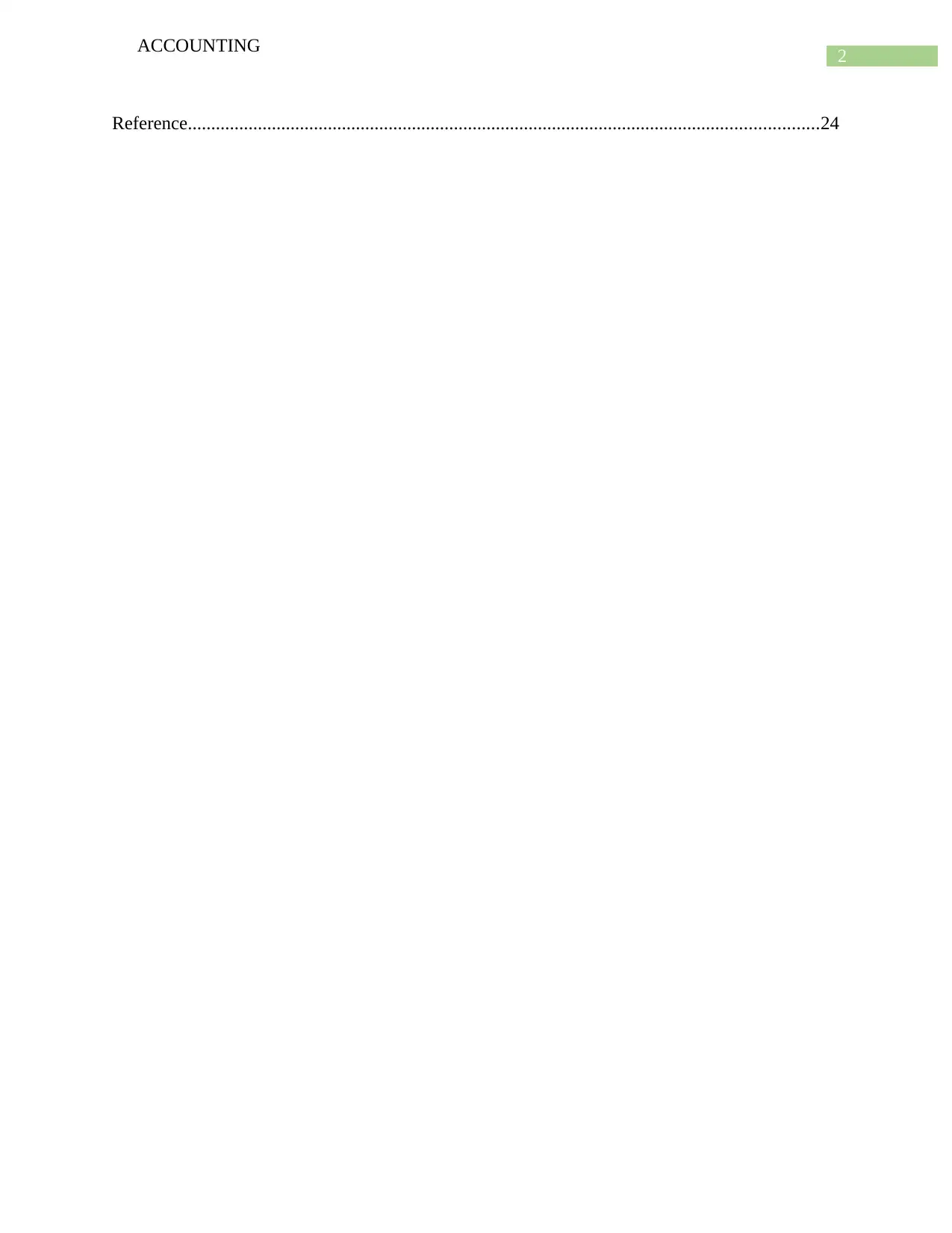
2
ACCOUNTING
Reference.......................................................................................................................................24
ACCOUNTING
Reference.......................................................................................................................................24
⊘ This is a preview!⊘
Do you want full access?
Subscribe today to unlock all pages.

Trusted by 1+ million students worldwide
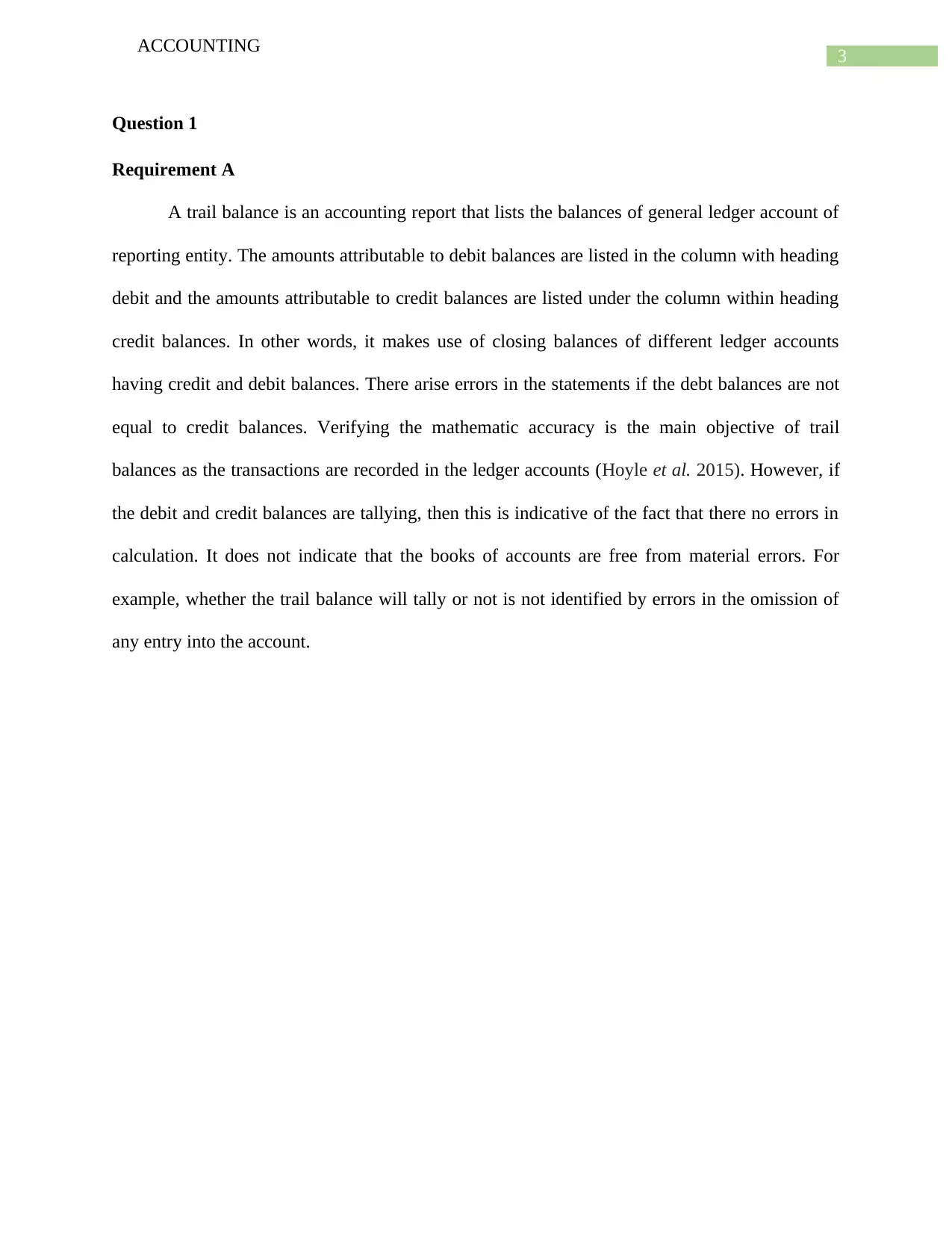
3
ACCOUNTING
Question 1
Requirement A
A trail balance is an accounting report that lists the balances of general ledger account of
reporting entity. The amounts attributable to debit balances are listed in the column with heading
debit and the amounts attributable to credit balances are listed under the column within heading
credit balances. In other words, it makes use of closing balances of different ledger accounts
having credit and debit balances. There arise errors in the statements if the debt balances are not
equal to credit balances. Verifying the mathematic accuracy is the main objective of trail
balances as the transactions are recorded in the ledger accounts (Hoyle et al. 2015). However, if
the debit and credit balances are tallying, then this is indicative of the fact that there no errors in
calculation. It does not indicate that the books of accounts are free from material errors. For
example, whether the trail balance will tally or not is not identified by errors in the omission of
any entry into the account.
ACCOUNTING
Question 1
Requirement A
A trail balance is an accounting report that lists the balances of general ledger account of
reporting entity. The amounts attributable to debit balances are listed in the column with heading
debit and the amounts attributable to credit balances are listed under the column within heading
credit balances. In other words, it makes use of closing balances of different ledger accounts
having credit and debit balances. There arise errors in the statements if the debt balances are not
equal to credit balances. Verifying the mathematic accuracy is the main objective of trail
balances as the transactions are recorded in the ledger accounts (Hoyle et al. 2015). However, if
the debit and credit balances are tallying, then this is indicative of the fact that there no errors in
calculation. It does not indicate that the books of accounts are free from material errors. For
example, whether the trail balance will tally or not is not identified by errors in the omission of
any entry into the account.
Paraphrase This Document
Need a fresh take? Get an instant paraphrase of this document with our AI Paraphraser
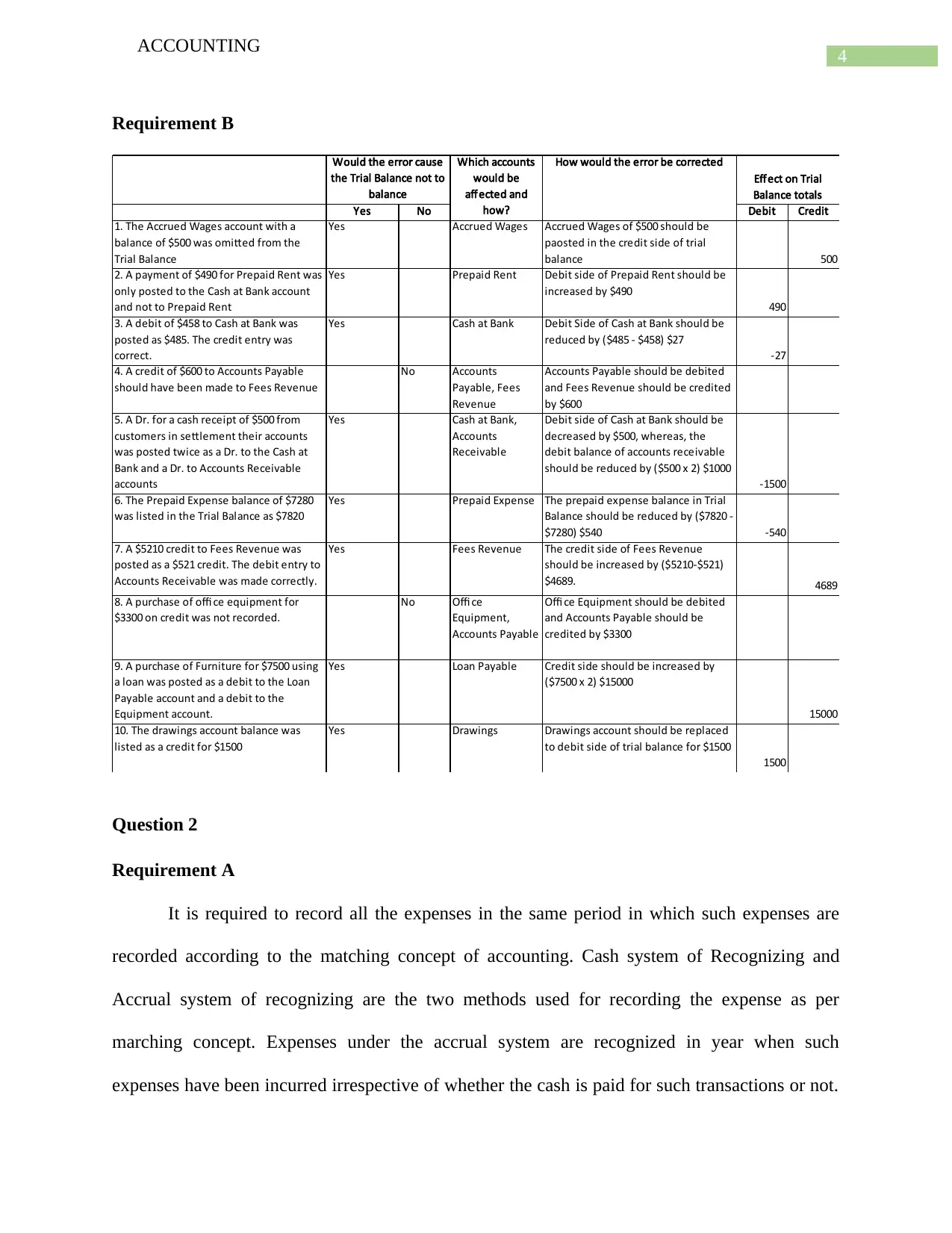
4
ACCOUNTING
Requirement B
Yes No Debit Credit
1. The Accrued Wages account with a
balance of $500 was omitted from the
Trial Balance
Yes Accrued Wages Accrued Wages of $500 should be
paosted in the credit side of trial
balance 500
2. A payment of $490 for Prepaid Rent was
only posted to the Cash at Bank account
and not to Prepaid Rent
Yes Prepaid Rent Debit side of Prepaid Rent should be
increased by $490
490
3. A debit of $458 to Cash at Bank was
posted as $485. The credit entry was
correct.
Yes Cash at Bank Debit Side of Cash at Bank should be
reduced by ($485 - $458) $27
-27
4. A credit of $600 to Accounts Payable
should have been made to Fees Revenue
No Accounts
Payable, Fees
Revenue
Accounts Payable should be debited
and Fees Revenue should be credited
by $600
5. A Dr. for a cash receipt of $500 from
customers in settlement their accounts
was posted twice as a Dr. to the Cash at
Bank and a Dr. to Accounts Receivable
accounts
Yes Cash at Bank,
Accounts
Receivable
Debit side of Cash at Bank should be
decreased by $500, whereas, the
debit balance of accounts receivable
should be reduced by ($500 x 2) $1000
-1500
6. The Prepaid Expense balance of $7280
was listed in the Trial Balance as $7820
Yes Prepaid Expense The prepaid expense balance in Trial
Balance should be reduced by ($7820 -
$7280) $540 -540
7. A $5210 credit to Fees Revenue was
posted as a $521 credit. The debit entry to
Accounts Receivable was made correctly.
Yes Fees Revenue The credit side of Fees Revenue
should be increased by ($5210-$521)
$4689. 4689
8. A purchase of offi ce equipment for
$3300 on credit was not recorded.
No Offi ce
Equipment,
Accounts Payable
Offi ce Equipment should be debited
and Accounts Payable should be
credited by $3300
9. A purchase of Furniture for $7500 using
a loan was posted as a debit to the Loan
Payable account and a debit to the
Equipment account.
Yes Loan Payable Credit side should be increased by
($7500 x 2) $15000
15000
10. The drawings account balance was
listed as a credit for $1500
Yes Drawings Drawings account should be replaced
to debit side of trial balance for $1500
1500
Would the error cause
the Trial Balance not to
balance
Which accounts
would be
affected and
how?
How would the error be corrected
Effect on Trial
Balance totals
Question 2
Requirement A
It is required to record all the expenses in the same period in which such expenses are
recorded according to the matching concept of accounting. Cash system of Recognizing and
Accrual system of recognizing are the two methods used for recording the expense as per
marching concept. Expenses under the accrual system are recognized in year when such
expenses have been incurred irrespective of whether the cash is paid for such transactions or not.
ACCOUNTING
Requirement B
Yes No Debit Credit
1. The Accrued Wages account with a
balance of $500 was omitted from the
Trial Balance
Yes Accrued Wages Accrued Wages of $500 should be
paosted in the credit side of trial
balance 500
2. A payment of $490 for Prepaid Rent was
only posted to the Cash at Bank account
and not to Prepaid Rent
Yes Prepaid Rent Debit side of Prepaid Rent should be
increased by $490
490
3. A debit of $458 to Cash at Bank was
posted as $485. The credit entry was
correct.
Yes Cash at Bank Debit Side of Cash at Bank should be
reduced by ($485 - $458) $27
-27
4. A credit of $600 to Accounts Payable
should have been made to Fees Revenue
No Accounts
Payable, Fees
Revenue
Accounts Payable should be debited
and Fees Revenue should be credited
by $600
5. A Dr. for a cash receipt of $500 from
customers in settlement their accounts
was posted twice as a Dr. to the Cash at
Bank and a Dr. to Accounts Receivable
accounts
Yes Cash at Bank,
Accounts
Receivable
Debit side of Cash at Bank should be
decreased by $500, whereas, the
debit balance of accounts receivable
should be reduced by ($500 x 2) $1000
-1500
6. The Prepaid Expense balance of $7280
was listed in the Trial Balance as $7820
Yes Prepaid Expense The prepaid expense balance in Trial
Balance should be reduced by ($7820 -
$7280) $540 -540
7. A $5210 credit to Fees Revenue was
posted as a $521 credit. The debit entry to
Accounts Receivable was made correctly.
Yes Fees Revenue The credit side of Fees Revenue
should be increased by ($5210-$521)
$4689. 4689
8. A purchase of offi ce equipment for
$3300 on credit was not recorded.
No Offi ce
Equipment,
Accounts Payable
Offi ce Equipment should be debited
and Accounts Payable should be
credited by $3300
9. A purchase of Furniture for $7500 using
a loan was posted as a debit to the Loan
Payable account and a debit to the
Equipment account.
Yes Loan Payable Credit side should be increased by
($7500 x 2) $15000
15000
10. The drawings account balance was
listed as a credit for $1500
Yes Drawings Drawings account should be replaced
to debit side of trial balance for $1500
1500
Would the error cause
the Trial Balance not to
balance
Which accounts
would be
affected and
how?
How would the error be corrected
Effect on Trial
Balance totals
Question 2
Requirement A
It is required to record all the expenses in the same period in which such expenses are
recorded according to the matching concept of accounting. Cash system of Recognizing and
Accrual system of recognizing are the two methods used for recording the expense as per
marching concept. Expenses under the accrual system are recognized in year when such
expenses have been incurred irrespective of whether the cash is paid for such transactions or not.
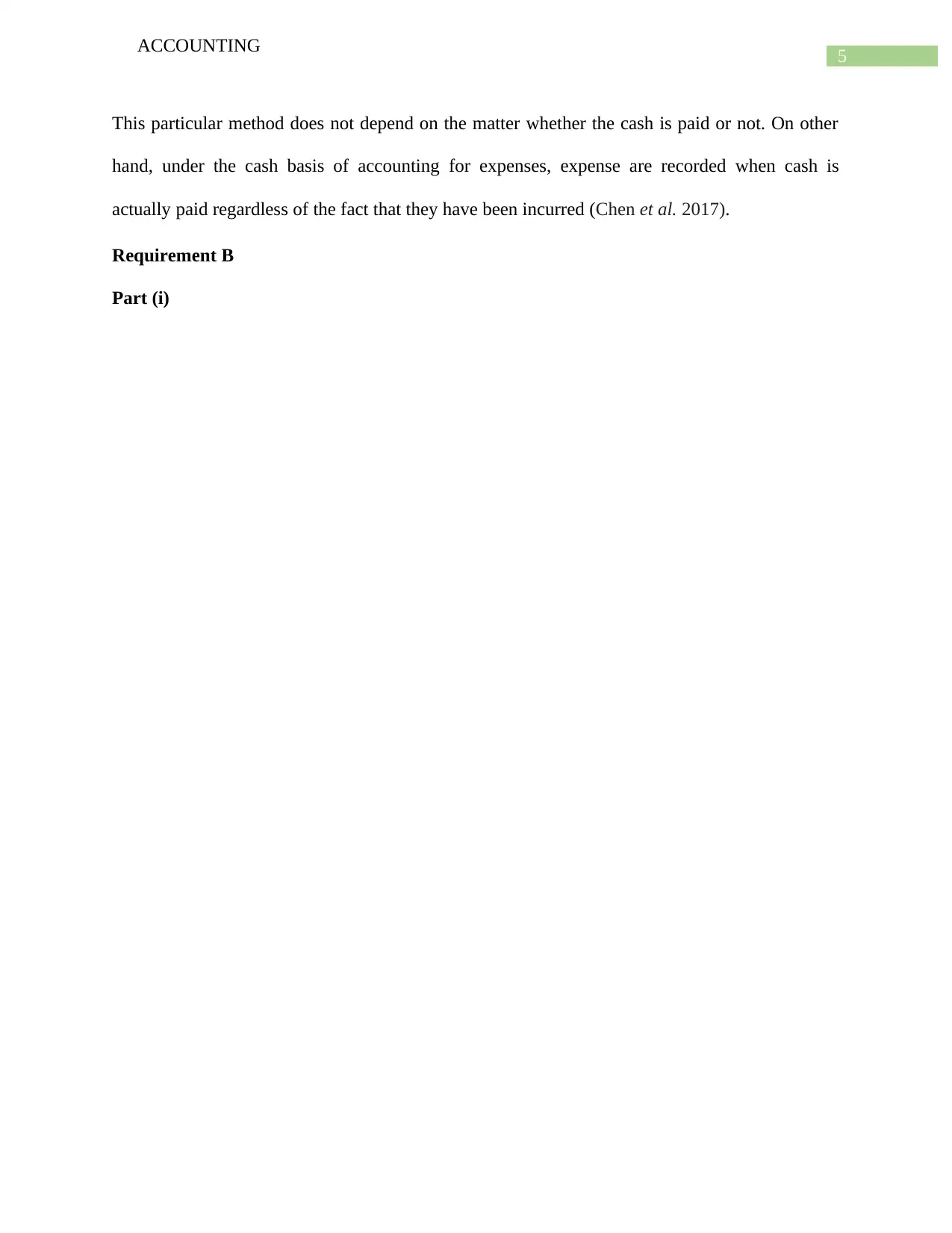
5
ACCOUNTING
This particular method does not depend on the matter whether the cash is paid or not. On other
hand, under the cash basis of accounting for expenses, expense are recorded when cash is
actually paid regardless of the fact that they have been incurred (Chen et al. 2017).
Requirement B
Part (i)
ACCOUNTING
This particular method does not depend on the matter whether the cash is paid or not. On other
hand, under the cash basis of accounting for expenses, expense are recorded when cash is
actually paid regardless of the fact that they have been incurred (Chen et al. 2017).
Requirement B
Part (i)
⊘ This is a preview!⊘
Do you want full access?
Subscribe today to unlock all pages.

Trusted by 1+ million students worldwide
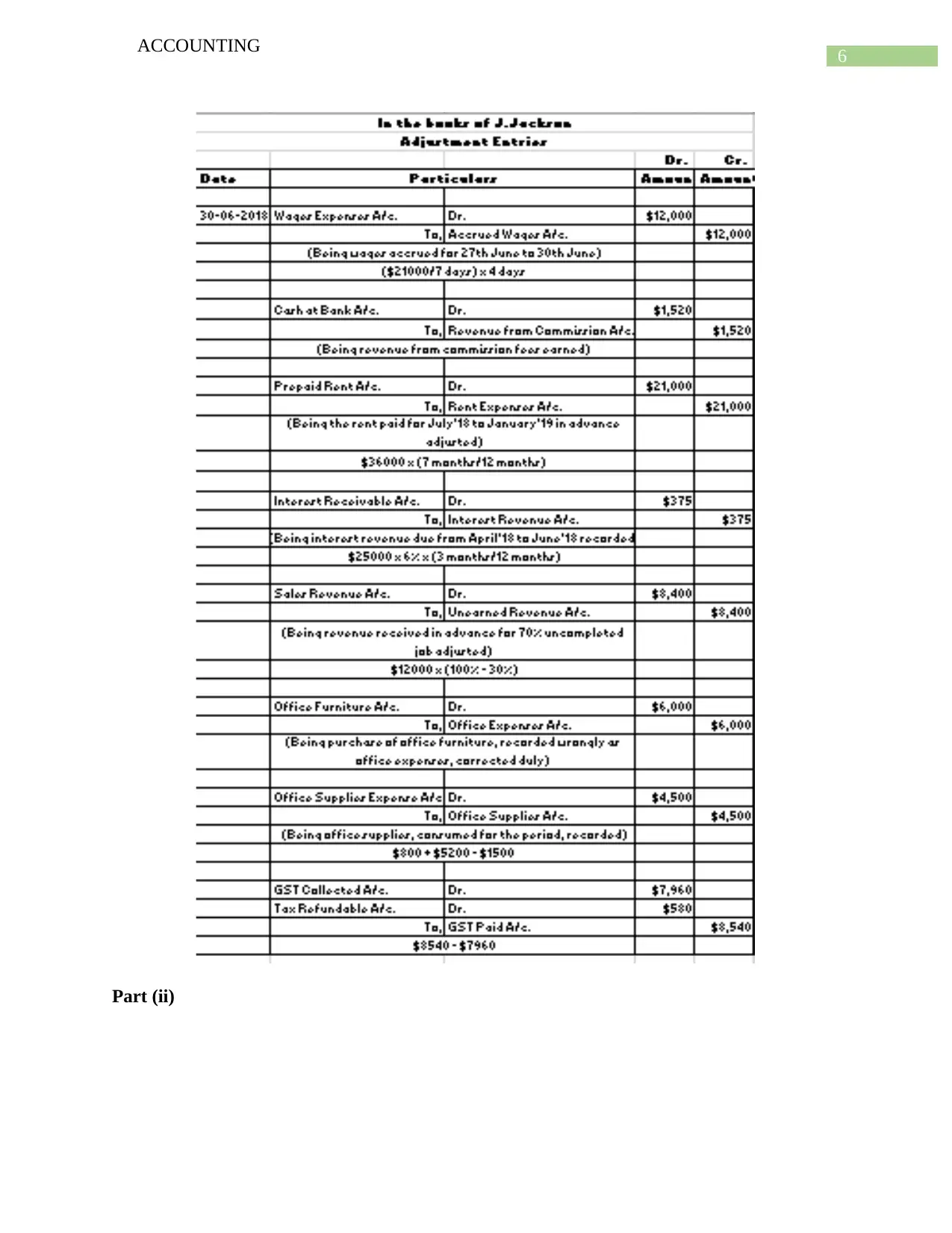
6
ACCOUNTING
Part (ii)
ACCOUNTING
Part (ii)
Paraphrase This Document
Need a fresh take? Get an instant paraphrase of this document with our AI Paraphraser
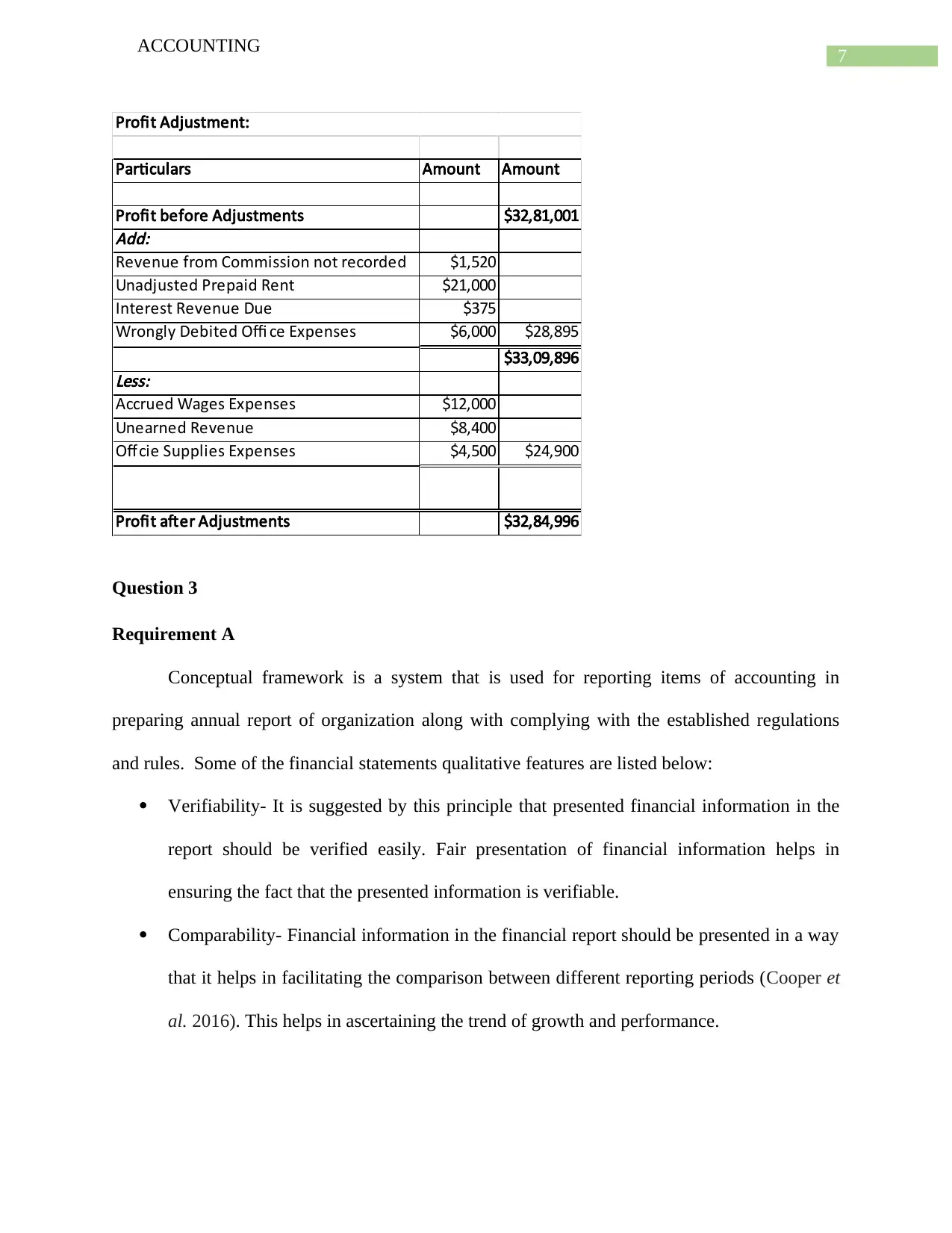
7
ACCOUNTING
Particulars Amount Amount
Profit before Adjustments $32,81,001Add:
Revenue from Commission not recorded $1,520
Unadjusted Prepaid Rent $21,000
Interest Revenue Due $375
Wrongly Debited Offi ce Expenses $6,000 $28,895
$33,09,896Less:
Accrued Wages Expenses $12,000
Unearned Revenue $8,400
Offcie Supplies Expenses $4,500 $24,900
Profit after Adjustments $32,84,996
Profit Adjustment:
Question 3
Requirement A
Conceptual framework is a system that is used for reporting items of accounting in
preparing annual report of organization along with complying with the established regulations
and rules. Some of the financial statements qualitative features are listed below:
Verifiability- It is suggested by this principle that presented financial information in the
report should be verified easily. Fair presentation of financial information helps in
ensuring the fact that the presented information is verifiable.
Comparability- Financial information in the financial report should be presented in a way
that it helps in facilitating the comparison between different reporting periods (Cooper et
al. 2016). This helps in ascertaining the trend of growth and performance.
ACCOUNTING
Particulars Amount Amount
Profit before Adjustments $32,81,001Add:
Revenue from Commission not recorded $1,520
Unadjusted Prepaid Rent $21,000
Interest Revenue Due $375
Wrongly Debited Offi ce Expenses $6,000 $28,895
$33,09,896Less:
Accrued Wages Expenses $12,000
Unearned Revenue $8,400
Offcie Supplies Expenses $4,500 $24,900
Profit after Adjustments $32,84,996
Profit Adjustment:
Question 3
Requirement A
Conceptual framework is a system that is used for reporting items of accounting in
preparing annual report of organization along with complying with the established regulations
and rules. Some of the financial statements qualitative features are listed below:
Verifiability- It is suggested by this principle that presented financial information in the
report should be verified easily. Fair presentation of financial information helps in
ensuring the fact that the presented information is verifiable.
Comparability- Financial information in the financial report should be presented in a way
that it helps in facilitating the comparison between different reporting periods (Cooper et
al. 2016). This helps in ascertaining the trend of growth and performance.
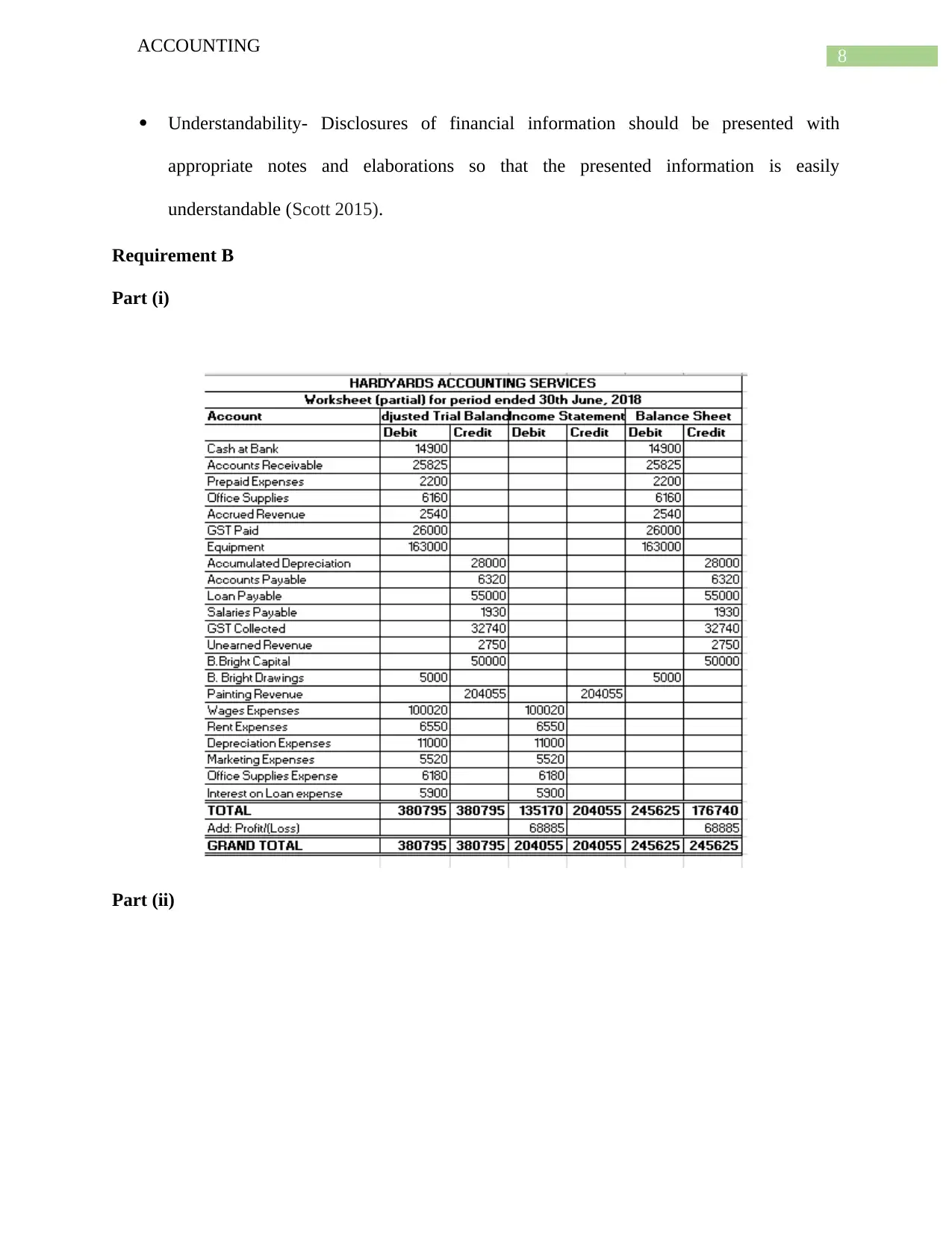
8
ACCOUNTING
Understandability- Disclosures of financial information should be presented with
appropriate notes and elaborations so that the presented information is easily
understandable (Scott 2015).
Requirement B
Part (i)
Part (ii)
ACCOUNTING
Understandability- Disclosures of financial information should be presented with
appropriate notes and elaborations so that the presented information is easily
understandable (Scott 2015).
Requirement B
Part (i)
Part (ii)
⊘ This is a preview!⊘
Do you want full access?
Subscribe today to unlock all pages.

Trusted by 1+ million students worldwide
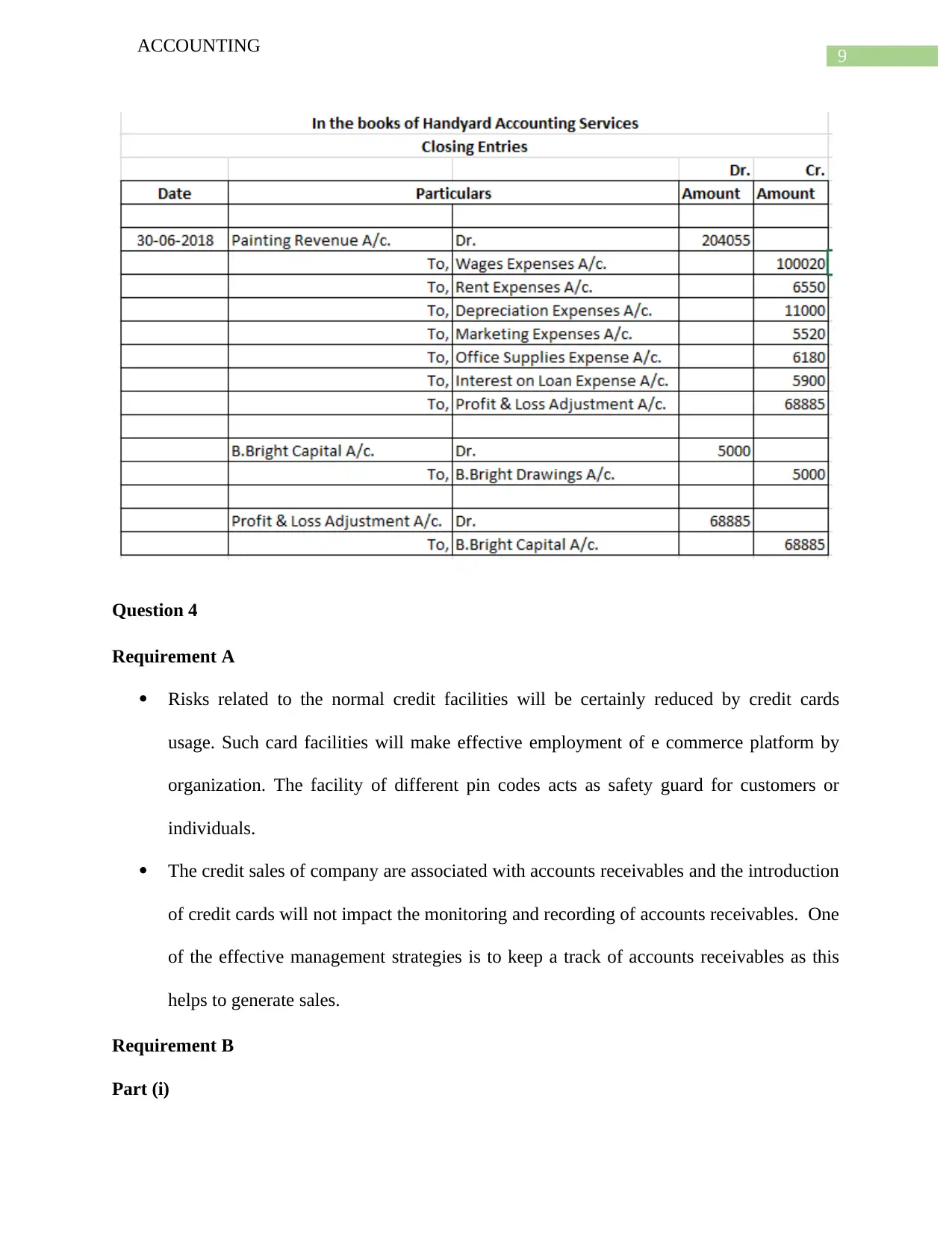
9
ACCOUNTING
Question 4
Requirement A
Risks related to the normal credit facilities will be certainly reduced by credit cards
usage. Such card facilities will make effective employment of e commerce platform by
organization. The facility of different pin codes acts as safety guard for customers or
individuals.
The credit sales of company are associated with accounts receivables and the introduction
of credit cards will not impact the monitoring and recording of accounts receivables. One
of the effective management strategies is to keep a track of accounts receivables as this
helps to generate sales.
Requirement B
Part (i)
ACCOUNTING
Question 4
Requirement A
Risks related to the normal credit facilities will be certainly reduced by credit cards
usage. Such card facilities will make effective employment of e commerce platform by
organization. The facility of different pin codes acts as safety guard for customers or
individuals.
The credit sales of company are associated with accounts receivables and the introduction
of credit cards will not impact the monitoring and recording of accounts receivables. One
of the effective management strategies is to keep a track of accounts receivables as this
helps to generate sales.
Requirement B
Part (i)
Paraphrase This Document
Need a fresh take? Get an instant paraphrase of this document with our AI Paraphraser
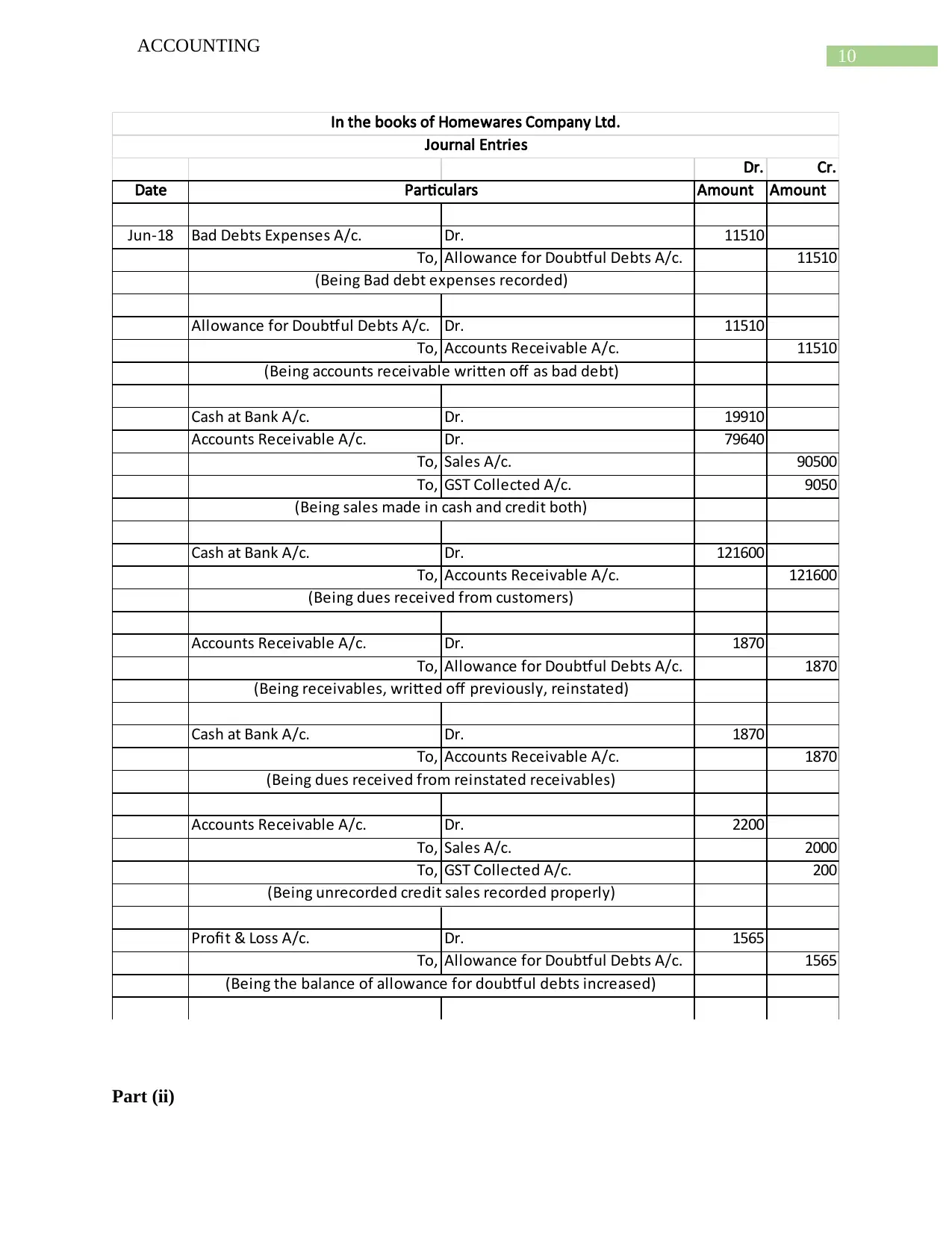
10
ACCOUNTING
Dr. Cr.
Date Amount Amount
Jun-18 Bad Debts Expenses A/c. Dr. 11510
To, Allowance for Doubtful Debts A/c. 11510
Allowance for Doubtful Debts A/c. Dr. 11510
To, Accounts Receivable A/c. 11510
Cash at Bank A/c. Dr. 19910
Accounts Receivable A/c. Dr. 79640
To, Sales A/c. 90500
To, GST Collected A/c. 9050
Cash at Bank A/c. Dr. 121600
To, Accounts Receivable A/c. 121600
Accounts Receivable A/c. Dr. 1870
To, Allowance for Doubtful Debts A/c. 1870
Cash at Bank A/c. Dr. 1870
To, Accounts Receivable A/c. 1870
Accounts Receivable A/c. Dr. 2200
To, Sales A/c. 2000
To, GST Collected A/c. 200
Profit & Loss A/c. Dr. 1565
To, Allowance for Doubtful Debts A/c. 1565
Journal Entries
(Being the balance of allowance for doubtful debts increased)
Particulars
(Being Bad debt expenses recorded)
(Being accounts receivable written off as bad debt)
(Being sales made in cash and credit both)
(Being dues received from customers)
(Being receivables, writted off previously, reinstated)
(Being dues received from reinstated receivables)
(Being unrecorded credit sales recorded properly)
In the books of Homewares Company Ltd.
Part (ii)
ACCOUNTING
Dr. Cr.
Date Amount Amount
Jun-18 Bad Debts Expenses A/c. Dr. 11510
To, Allowance for Doubtful Debts A/c. 11510
Allowance for Doubtful Debts A/c. Dr. 11510
To, Accounts Receivable A/c. 11510
Cash at Bank A/c. Dr. 19910
Accounts Receivable A/c. Dr. 79640
To, Sales A/c. 90500
To, GST Collected A/c. 9050
Cash at Bank A/c. Dr. 121600
To, Accounts Receivable A/c. 121600
Accounts Receivable A/c. Dr. 1870
To, Allowance for Doubtful Debts A/c. 1870
Cash at Bank A/c. Dr. 1870
To, Accounts Receivable A/c. 1870
Accounts Receivable A/c. Dr. 2200
To, Sales A/c. 2000
To, GST Collected A/c. 200
Profit & Loss A/c. Dr. 1565
To, Allowance for Doubtful Debts A/c. 1565
Journal Entries
(Being the balance of allowance for doubtful debts increased)
Particulars
(Being Bad debt expenses recorded)
(Being accounts receivable written off as bad debt)
(Being sales made in cash and credit both)
(Being dues received from customers)
(Being receivables, writted off previously, reinstated)
(Being dues received from reinstated receivables)
(Being unrecorded credit sales recorded properly)
In the books of Homewares Company Ltd.
Part (ii)
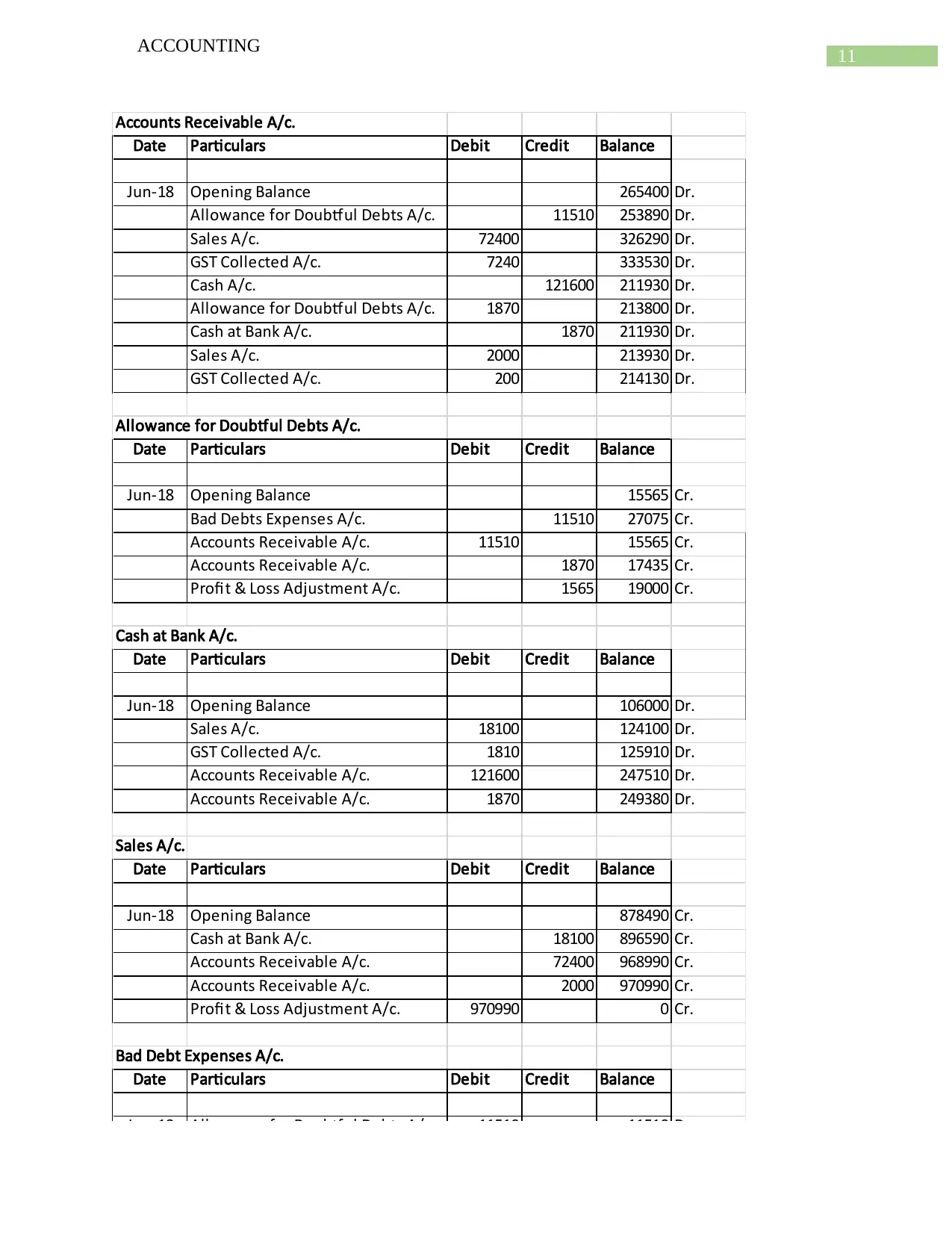
11
ACCOUNTING
Accounts Receivable A/c.
Date Particulars Debit Credit Balance
Jun-18 Opening Balance 265400 Dr.
Allowance for Doubtful Debts A/c. 11510 253890 Dr.
Sales A/c. 72400 326290 Dr.
GST Collected A/c. 7240 333530 Dr.
Cash A/c. 121600 211930 Dr.
Allowance for Doubtful Debts A/c. 1870 213800 Dr.
Cash at Bank A/c. 1870 211930 Dr.
Sales A/c. 2000 213930 Dr.
GST Collected A/c. 200 214130 Dr.
Allowance for Doubtful Debts A/c.
Date Particulars Debit Credit Balance
Jun-18 Opening Balance 15565 Cr.
Bad Debts Expenses A/c. 11510 27075 Cr.
Accounts Receivable A/c. 11510 15565 Cr.
Accounts Receivable A/c. 1870 17435 Cr.
Profit & Loss Adjustment A/c. 1565 19000 Cr.
Cash at Bank A/c.
Date Particulars Debit Credit Balance
Jun-18 Opening Balance 106000 Dr.
Sales A/c. 18100 124100 Dr.
GST Collected A/c. 1810 125910 Dr.
Accounts Receivable A/c. 121600 247510 Dr.
Accounts Receivable A/c. 1870 249380 Dr.
Sales A/c.
Date Particulars Debit Credit Balance
Jun-18 Opening Balance 878490 Cr.
Cash at Bank A/c. 18100 896590 Cr.
Accounts Receivable A/c. 72400 968990 Cr.
Accounts Receivable A/c. 2000 970990 Cr.
Profit & Loss Adjustment A/c. 970990 0 Cr.
Bad Debt Expenses A/c.
Date Particulars Debit Credit Balance
Jun-18 Allowance for Doubtful Debts A/c. 11510 11510 Dr.
Profit & Loss Adjustment A/c. 11510 0
ACCOUNTING
Accounts Receivable A/c.
Date Particulars Debit Credit Balance
Jun-18 Opening Balance 265400 Dr.
Allowance for Doubtful Debts A/c. 11510 253890 Dr.
Sales A/c. 72400 326290 Dr.
GST Collected A/c. 7240 333530 Dr.
Cash A/c. 121600 211930 Dr.
Allowance for Doubtful Debts A/c. 1870 213800 Dr.
Cash at Bank A/c. 1870 211930 Dr.
Sales A/c. 2000 213930 Dr.
GST Collected A/c. 200 214130 Dr.
Allowance for Doubtful Debts A/c.
Date Particulars Debit Credit Balance
Jun-18 Opening Balance 15565 Cr.
Bad Debts Expenses A/c. 11510 27075 Cr.
Accounts Receivable A/c. 11510 15565 Cr.
Accounts Receivable A/c. 1870 17435 Cr.
Profit & Loss Adjustment A/c. 1565 19000 Cr.
Cash at Bank A/c.
Date Particulars Debit Credit Balance
Jun-18 Opening Balance 106000 Dr.
Sales A/c. 18100 124100 Dr.
GST Collected A/c. 1810 125910 Dr.
Accounts Receivable A/c. 121600 247510 Dr.
Accounts Receivable A/c. 1870 249380 Dr.
Sales A/c.
Date Particulars Debit Credit Balance
Jun-18 Opening Balance 878490 Cr.
Cash at Bank A/c. 18100 896590 Cr.
Accounts Receivable A/c. 72400 968990 Cr.
Accounts Receivable A/c. 2000 970990 Cr.
Profit & Loss Adjustment A/c. 970990 0 Cr.
Bad Debt Expenses A/c.
Date Particulars Debit Credit Balance
Jun-18 Allowance for Doubtful Debts A/c. 11510 11510 Dr.
Profit & Loss Adjustment A/c. 11510 0
⊘ This is a preview!⊘
Do you want full access?
Subscribe today to unlock all pages.

Trusted by 1+ million students worldwide
1 out of 23
Related Documents
Your All-in-One AI-Powered Toolkit for Academic Success.
+13062052269
info@desklib.com
Available 24*7 on WhatsApp / Email
![[object Object]](/_next/static/media/star-bottom.7253800d.svg)
Unlock your academic potential
Copyright © 2020–2025 A2Z Services. All Rights Reserved. Developed and managed by ZUCOL.





